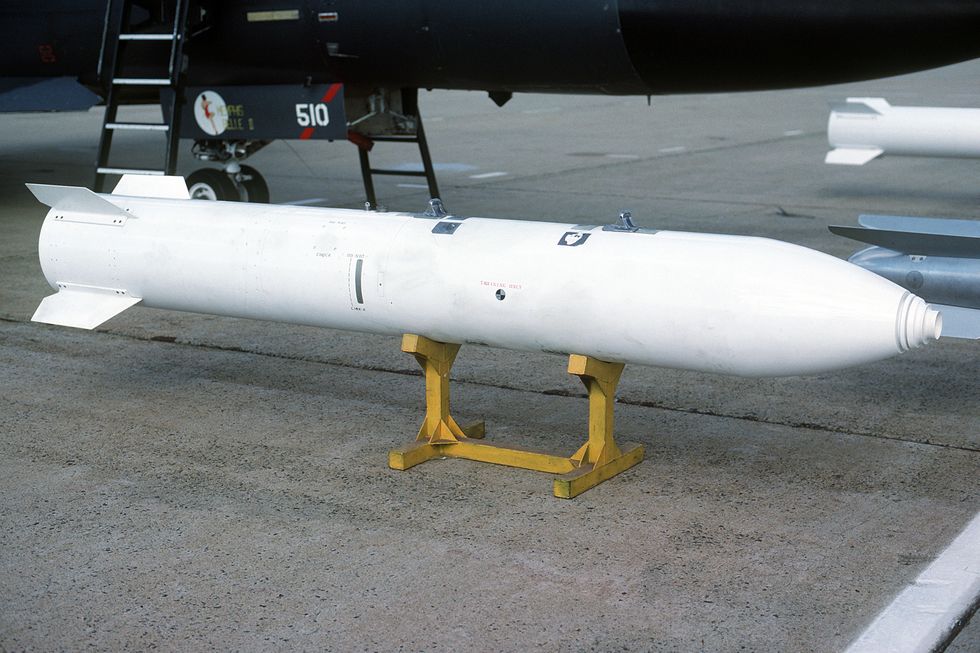KYLE MIZOKAMI
President Biden’s administration is proposing taking older nuclear bombs and rebuilding them into new ones, so the Pentagon can replace the largest nuke in its arsenal.
The proposed B61-13 would replace a much bigger, more dangerous bomb, but would still have one of the largest yields in the American nuclear arsenal. The new bomb would follow two other nukes recently rebuilt from older weapons, the B61-12 gravity bomb and the W76-2 submarine missile warhead—all part of an effort to keep pace with nuclear-armed adversaries.
America’s Nuclear Bombs
America’s nuclear weapons are typically divided between warheads carried on missiles and aircraft-dropped gravity bombs. There are two serving types of gravity bombs, the B61 series developed in the 1960s by Los Alamos and the B83.
The B61 series bombs have a “dial-a-yield” control system that allows the explosive yield of the bomb to be adjusted to fit the mission requirements, from the equivalent of 300 tons (.3 kilotons) of explosive to 360,000 tons (360 kilotons). The bomb dropped on Hiroshima, Japan, was just 15,000 tons (15 kilotons). The B61 series can be dropped by the B-2 and B-21 bombers and F-35, F-15E, and F-16 fighters.

An F-35 fighter jet drops a B61-12 bomb.DOD F-35 Joint Program Office
Of the 13 B61 variants, six are still in service, with one under development and the rest canceled or retired. Each has a different role: The B61-3, -4, and -10 are tactical weapons, useful against above-ground targets, such as troop concentrations, military bases, or other important fixed tactical targets. The B61-7 is classified as a strategic weapon and would be used in a general nuclear war against strategic targets like ports, factories, oil refineries, and other targets, and has a larger explosive yield. The B61-11 is a strategic “bunker buster” with a steel case, for penetrating up to 20 feet of earth. A sixth variant, the B61-12 (shown in the top image), is the most accurate version and was developed in the 2010s to replace older versions.
The other nuclear bomb, the B83, can only be dropped by the B-2 Spirit bomber. It has a whopping 1.2 megaton (1,200 kiloton) warhead and is the largest warhead in the arsenal today. It is arguably unnecessary at this point, and there were plans to retire it, but the bomb was saved by the Trump Administration for unknown reasons.
A “New” Nuke
The new weapon is designated B61-13, the 13th and latest variant, though it won’t be entirely new. The B61-13 will recycle B61-7 warheads with 360 kiloton yields, so the overall U.S. nuclear stockpile won’t actually grow larger. According to the Arms Control Association, an estimated 215 B61-7s are in the stockpile.
According to the Department of Defense, the B61-13 is necessary due to an “evolving security environment.” The Pentagon doesn’t outright name any countries that are spurring the new bomb’s development, but North Korea, Iran, China, and Russia are all potential targets. The new bomb “will provide the President with additional options against certain harder and large-area military targets.” The bomb will also incorporate the “modern safety, security, and accuracy features” recently developed for the B61-12 bomb.
The bomb’s limited ability to penetrate the ground could make it a candidate against buried North Korean or Iranian facilities—Russian and Chinese hardened facilities are probably too deep and well constructed. An early analysis by the Bulletin of the Atomic Scientists suggests a use against North Korea. The B61-12 was originally developed to hit buried targets but maxes out at 50 kilotons—a bigger, 360 kiloton warhead would have a deeper underground reach. The apparent need for the new bomb suggests the underground facilities of potential adversaries might be deeper than previously thought.

A B83 nuclear bomb casing.U.S. Air Force/Master Sgt. Ken Hammond
The B61-13 will replace the B83 bomb. At 1.2 megatons, or 1,200 kilotons, the B83 is the largest bomb in America’s inventory. The B83 exists to vaporize large targets, but it is older and less accurate. The Pentagon believes that the new, more accurate bomb—although smaller—will make up for the B83’s ability to create a giant nuclear fireball 1.2 miles in diameter.
An Evolving Arsenal
The proposed new bomb is the third “new” nuclear weapon since the end of the Cold War in 1991. The Obama Administration greenlighted the B61-12 bomb, which was meant to modernize the bulk of the B61 tactical arsenal. The Trump Administration then developed and deployed the W76-2 warhead on the Trident D-5 missile for the Ohio-class ballistic missile submarines. The W76-2 has just a 5 kiloton yield and was designed to give submarines the ability to launch tactical nuclear weapons. The B61-13 will be the third weapon proposed in the last three presidential administrations.

An unarmed Trident II D5 missile launches from the Ohio-class ballistic missile submarine USS Nebraska (SSBN 739) off the coast of California. The new W76-2 low-yield nuclear warhead was designed for the Trident II missile.U.S. Navy photo by Mass Communication Specialist 1st Class Ronald Gutridge/Released
So far, all of the weapons have involved recycling the design and nuclear materials from older weapons. Plus, “the number of B61-12s to be produced will be lowered by the same amount as the number of B61-13s produced,” according to the Department of Defense. Once all three programs are complete, there should be no increase in the overall number of nuclear weapons in the U.S.’s stockpile.
The Takeaway
Nuclear weapons development largely ceased when the Cold War ended, but the rise of Chinese military power, North Korea’s nuclear arsenal, and Iran’s attempts to build nukes have all placed new strains on the international order. The new bomb is part of an overall attempt to pace these threats and match weapons to various contingencies.
But the question remains: did America really need a new bomb, and all the costs associated with it, now?
No comments:
Post a Comment